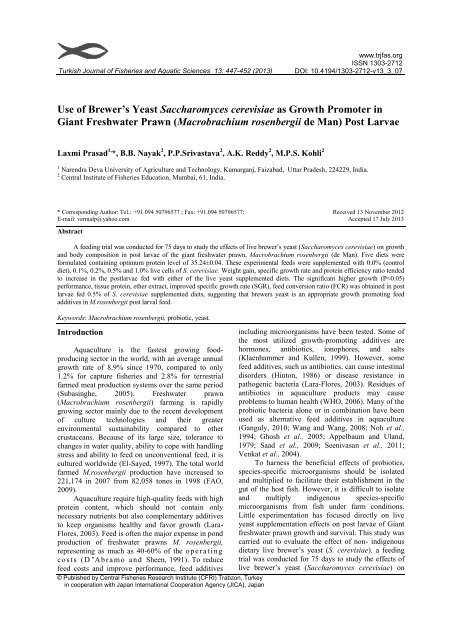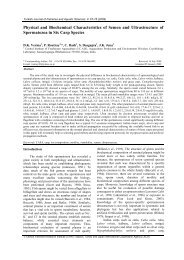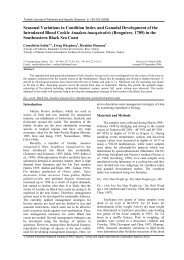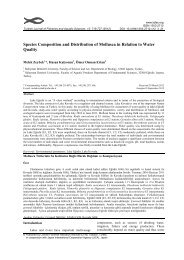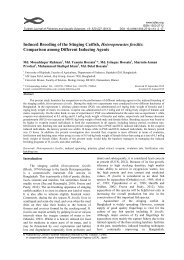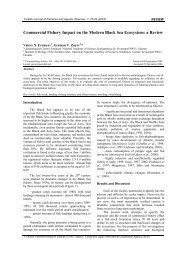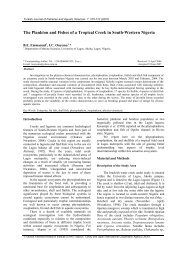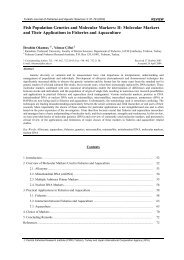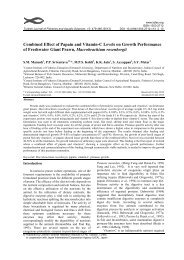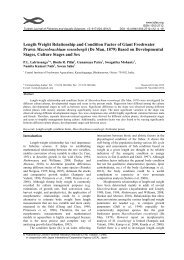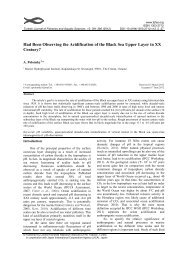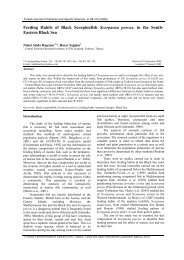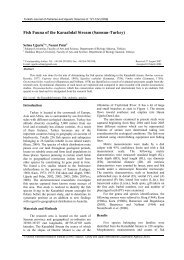Use of Brewer's Yeast Saccharomyces cerevisiae as Growth ...
Use of Brewer's Yeast Saccharomyces cerevisiae as Growth ...
Use of Brewer's Yeast Saccharomyces cerevisiae as Growth ...
You also want an ePaper? Increase the reach of your titles
YUMPU automatically turns print PDFs into web optimized ePapers that Google loves.
L. Pr<strong>as</strong>ad et al. / Turk. J. Fish. Aquat. Sci. 13: 447-452 (2013) 449<strong>of</strong> the extract w<strong>as</strong> expressed <strong>as</strong> a percent <strong>of</strong> the tissueweight. Ash content w<strong>as</strong> estimated by incineratingsamples in a muffle furnace at 600°C for 6 hours. Totalcarbohydrate (%) w<strong>as</strong> calculated by subtractingprotein, fat, moisture, and <strong>as</strong>h from the total weight.Proximate carc<strong>as</strong>s compositions were analyzed beforeinitiation and after termination <strong>of</strong> the experiment.<strong>Growth</strong> StudyPost larvae from each tank were bulk weighed atthe end <strong>of</strong> experimental duration <strong>of</strong> 75 days. <strong>Growth</strong>performance w<strong>as</strong> <strong>as</strong>sessed <strong>as</strong> percent wt gain =100(final wt - initial wt)/initial wt, specific growthrate (SGR) = 100(ln final body wt - ln initial bodywt)/75 days, feed conversion ratio (FCR) = wt feedgiven/wt gain, protein efficiency ratio (PER) = wtgain/protein intake, and apparent net proteinutilization (ANPU) = 100(final carc<strong>as</strong>s protein -initial carc<strong>as</strong>s protein)/protein fed.Statistical AnalysisData were statistically analyzed using SPSSversion 16.0. One-way analysis <strong>of</strong> variance(ANOVA) and Duncan ' s Multiple Range Test(Duncan, 1955) were applied to compare meansbetween treatments.Results and Discussion<strong>Ye<strong>as</strong>t</strong> Survival in FeedThe survival <strong>of</strong> ye<strong>as</strong>t in experimental feedsaffects growth performance <strong>of</strong> the host. In the presentstudy, the number <strong>of</strong> colony forming units in the feedsdropped <strong>as</strong> the storage period <strong>of</strong> the feed incre<strong>as</strong>ed(Table 2). Gabriel Aguirre-Guzman (2002) alsoobserved reduced counts <strong>of</strong> agglomerated S.<strong>cerevisiae</strong> in pelleted shrimp feeds, though the level<strong>of</strong> reduction may vary according to the procedureapplied and temperature and moisture level used fordrying.Gut MicrobesPseudomon<strong>as</strong> spp. Citrobacter spp. Aeromon<strong>as</strong>spp., Enterobacter spp., and Proteus spp., <strong>of</strong> bacteriawere commonly occurring in gills <strong>of</strong> post larvae.Citrobacter spp. Aeromon<strong>as</strong> spp., Enterobacter spp.,Plesiomon<strong>as</strong> spp., and Streptococcus spp., werecommonly occurring bacteria observed inhepatopancre<strong>as</strong>. Pseudomon<strong>as</strong> spp., Citrobacter spp.,Pantoea spp., Streptoccus spp., Sphingomon<strong>as</strong> spp.,Micrococcus spp., were most common bacterialgenera observed in haemolymph <strong>of</strong> post larvae <strong>of</strong>M.rosenbergii. Commonly observed bacterial generain gut <strong>of</strong> post larvae were Bacillus spp., Enterobacterspp., Pseudomon<strong>as</strong> spp., Streptococcus spp.,Klebsiella species. The occurrence <strong>of</strong> bacteria mayvary according to the water quality characteristicsused in rearing <strong>of</strong> post larva and bacterial load presentin feed supplied to the early larval stages. Bacterialcomposition in pond water, hatchery and larvae,rearing water h<strong>as</strong> been studied by Lalitha andSurendran (2004); and Uddin and Al-Harbi (2005),also reported some similar genera <strong>as</strong> observed in thisstudy. Colony characteristics and biochemical testsshowed that S. <strong>cerevisiae</strong> w<strong>as</strong> not present among theindigenous micr-<strong>of</strong>lora in the post larvae.Biochemical Composition <strong>of</strong> Feeds and Carc<strong>as</strong>sesBiochemical compositions and brewer’s ye<strong>as</strong>tcontent contents <strong>of</strong> the diets are presented in Table 3.Protein content <strong>of</strong> the diets were varying between35.23±0.04 to 35.24±0.10 percent. Lipid content <strong>of</strong>diets were varying between 5.63±0.05 to5.66±0.02.The diets prepared were statistically similarin their protein and lipid and carbohydrates values.After the feeding trail the proximate composition<strong>of</strong> the post larvae shows that the carc<strong>as</strong>s protein andlipid content in post larvae fed the supplementedfeeds are containing significantly higher protein andlipid amount(P
450 L. Pr<strong>as</strong>ad et al. / Turk. J. Fish. Aquat. Sci. 13: 447-452 (2013)(Gomezgil, 1995). Various species <strong>of</strong> ye<strong>as</strong>t anddifferent ye<strong>as</strong>t containing products have been fed t<strong>of</strong>ish and crustaceans for <strong>as</strong>sortment <strong>of</strong> re<strong>as</strong>ons.Dietary ye<strong>as</strong>t h<strong>as</strong> been reported to improve thegrowth <strong>of</strong> fish species also (Noh et al., 1994; Oliva-Teles and Goncalves, 2001; Lara-Flores et al., 2003;Li and Gatlin; 2003, 2004).In addition to probableimmunostimulant properties ( Siwicki et al., 1994;Nakano et al., 1995). In the present study, all thefour ye<strong>as</strong>t supplemented diets showed better resultthan with control diet (Table 4). The highest weightgain percentage, SGR, PER, and ANPU and lowestFCR (P
L. Pr<strong>as</strong>ad et al. / Turk. J. Fish. Aquat. Sci. 13: 447-452 (2013) 451Table 5. <strong>Growth</strong> performance <strong>of</strong> M. rosenbergii fed experimental diets for 75 days (meansd) supplemented with<strong>Saccharomyces</strong> <strong>cerevisiae</strong> supplemented dietsPerformance 0.0%Y 0.1%Y 0.2%Y 0.5%Y 1.0%YInitial weight (mg) 92.333.56 a 92.663.01 a 94.002.17 a 91.662.75 a 92.662.51 aFinal weight (mg) 421.482.74 a 461.112.93 b 486.482.31 d 477.965.56 c 455.372.56 bLive weight gain (%) 356.64±9.36 a 397.89±13.74 bc 417.71±11.73 bc 421.84±9.65 d 391.61±11.78 bSGR (% per day) 2.02±0.02 a 2.14±0.03 bc 2.19±0.03 c 2.19±0.30 c 2.12±0.03 bcFCR 1.95±0.05 c 1.72±0.02 b 1.67±0.04 ab 1.61±0.03 a 1.73±0.02 bPER 1.45±0.03 a 1.64±0.02 bc 1.72±0.04 bc 1.76±0.10 cd 1.63±0.04 bANPU 22.36±2.04 a 25.00±6.89 ab 32.06±1.01 c 32.42±5.25 c 32.22±0.48 cSurvival (%) 90 90 90 90 90*Value with identical superscript letters in the same row are significantly different (P
452 L. Pr<strong>as</strong>ad et al. / Turk. J. Fish. Aquat. Sci. 13: 447-452 (2013)and the prebiotic grobiotic AE influence growthperformance, immune responses and resistance <strong>of</strong>hybrid striped b<strong>as</strong>s (Morone chrysops, M. saxatilis) toStreptococcus iniae infection. Aquaculture, 231: 445–456. doi:10.1016/j.aquaculture.2003.08.021.Nakano, T., Tosa, M. and Takeuchi, M. 1995.Improvement <strong>of</strong> biochemical features in fish healthby red ye<strong>as</strong>t and synthetic <strong>as</strong>taxanthin. J. Agric.Food Chem., 43: 1570–1573.doi:10.1021/Jf00050a029Noh, S.H., Han, I.K., Won, T.H. and Choi, Y.J. 1994.Effect <strong>of</strong> antibiotics, enzyme, ye<strong>as</strong>t culture andprobiotics on the growth performance <strong>of</strong> Israelicarp. Korean Anim. Sci., 36: 480–486.Oliva-Teles, A. and Goncalves, P. 2001. Partialreplacement <strong>of</strong> fish-meal by brewers ye<strong>as</strong>t<strong>Saccharomyces</strong> cerevisae in diets for sea b<strong>as</strong>sDicentrarchus labrax juveniles. Aquaculture, 202:269–278. doi:10.1016/S0044-8486(01)00777-3Pr<strong>as</strong>ad. L., Nayak, B.B., Reddy, A.K., Kohili, M.P.S. andSriv<strong>as</strong>tava, P.P. 2012. Effect <strong>of</strong> exogenouslactobacillus supplementation on growth and feedefficiency <strong>of</strong> freshwater prawn M.rosenbergii (deMan). Israeli Journal <strong>of</strong> Aquaculture: Bamidgeh, 64:676-682.Saad, S.A., Hab<strong>as</strong>hy, M.M. and Sharshar, M.K. 2009.<strong>Growth</strong> response <strong>of</strong> the freshwater prawn,Macrobrachium rosenbergii (De Man), to dietshaving different levels <strong>of</strong> Biogen®. World AppliedSciences Journal, 6: 550-556.Seeniv<strong>as</strong>an, C., Saravana Bhavan, P. and Radhakrishnan,S. 2011. Effect <strong>of</strong> probiotics (Binifit TM ) on survival,growth, biochemical constituents and energy budget<strong>of</strong> the freshwater prawn Macrobrachiumrosenbergii post larvae. Elixir Aquaculture, 41: 5919-5927.Shcherbina, M.A., Tr<strong>of</strong>imova, L.N., Salkova, I.A. andGrin, A.V. 1987. Availability <strong>of</strong> amino acids inye<strong>as</strong>t raised on hydrocarbons for carp, Cyprinuscarpio. J. Ichthyol., 27: 23–28.Siwicki, A.K., Anderson, D.P. and Rumsey, G.L. 1994.Dietary intake <strong>of</strong> immunostimulants by rainbowtrout affects non-specific immunity and protectionagainst furunculosis. Vet. Immunol.Immunopathol., 41: 125–139.doi:10.1016/0165-2427(94)90062-0Sub<strong>as</strong>inghe, R.P. 2005. Epidemiological approach toaquatic animal health management: opportunities andchallenges for developing countries to incre<strong>as</strong>eaquatic production through aquaculture. Prev. Vet.Med., 67: 117–124.doi:10.1016/j.prevetmed.2004.11.004Suralikar, V. and Sahu, N.P. 2001. Effect <strong>of</strong> feedingprobiotic (Lactobacillus cremoris) on growth andsurvival <strong>of</strong> Macrobrachium rosenbergii postlarvae.J. Appl. Anim. Res., 20: 117-124. doi:10.1080/09712119.2001.9706744Swain, S.K., Rangacharyulu, P.V., Sarkar S.K. and D<strong>as</strong>,.K.M. 1996. Effect <strong>of</strong> a probiotic supplementation ongrowth, nutrient utilization and carc<strong>as</strong>s composition inMrigala fry. Journal <strong>of</strong> Aquaculture, 4: 29-35.Tovar, D., Zambonino, J., Cahu, C., Gatesoupe, F.J.,Vazquez-Juarez, R. and Lesel, R. 2002. Effect <strong>of</strong>live ye<strong>as</strong>t incorporation in compound diet ondigestive enzyme activity in sea b<strong>as</strong>s (Dicentrarchuslabrax) larvae. Aquaculture, 204 (1): 113–123.doi:10.1016/S00448486(01)00650-0Tovar-Ramırez, D., Zambonino Infante, J., Cahu, C.,Gatesoupe, F.J. and Vazquez-Juarez, R. 2004.Influence <strong>of</strong> dietary live ye<strong>as</strong>t on European sea b<strong>as</strong>s(Dicentrarchus labrax) larval development.Aquaculture, 234: 415–427.doi:10.1016/j.aquaculture.2004.01.028.Uddin, M. N. and Al-Harbi, A.H. 2005. Quantitative andqualitative bacterial flora <strong>of</strong> giant freshwater prawnMacrobrachium rosenbergii in earthen ponds in SaudiArabia. Journal <strong>of</strong> Aquatic Animal Health, 17: 244-250.doi: 10.1577/H03-027.1Vazquez-Juarez, R., Ascencio, F., Andlid, T.,Gustafsson, L. and Wadstrom, T. 1993. Theexpression <strong>of</strong> potential colonization factors <strong>of</strong>ye<strong>as</strong>ts isolated from fish during different growthconditions. Can. J. Microbiol., 39: 1135–1141.doi:10.1139/m93-171Venkat, H.K., Narottam, P.S. and Kamal, K.J. 2004. Effect<strong>of</strong> feeding Lactobacillus-b<strong>as</strong>ed probiotics on the gutmicr<strong>of</strong>lora, growth and survival <strong>of</strong> postlarvae <strong>of</strong>Macrobrachium rosenbergii (De Man). Aquacul.Res., 35: 501-507. doi:10.1111/J.1365-2109.2004.01045.xWang, Y.M. and Wang, Y.G. 2008. Advance in themechanisms and application <strong>of</strong> micro-ecologics inaquaculture. Prog. Vet. Med., 29:72-75 (in Chinese).WHO, 2006. Report <strong>of</strong> a Joint FAO/OIE/WHO ExpertConsultation on Antimicrobial <strong>Use</strong> in Aquacultureand Antimicrobial Resistance: Seoul, Republic <strong>of</strong>Korea: 13-16.


